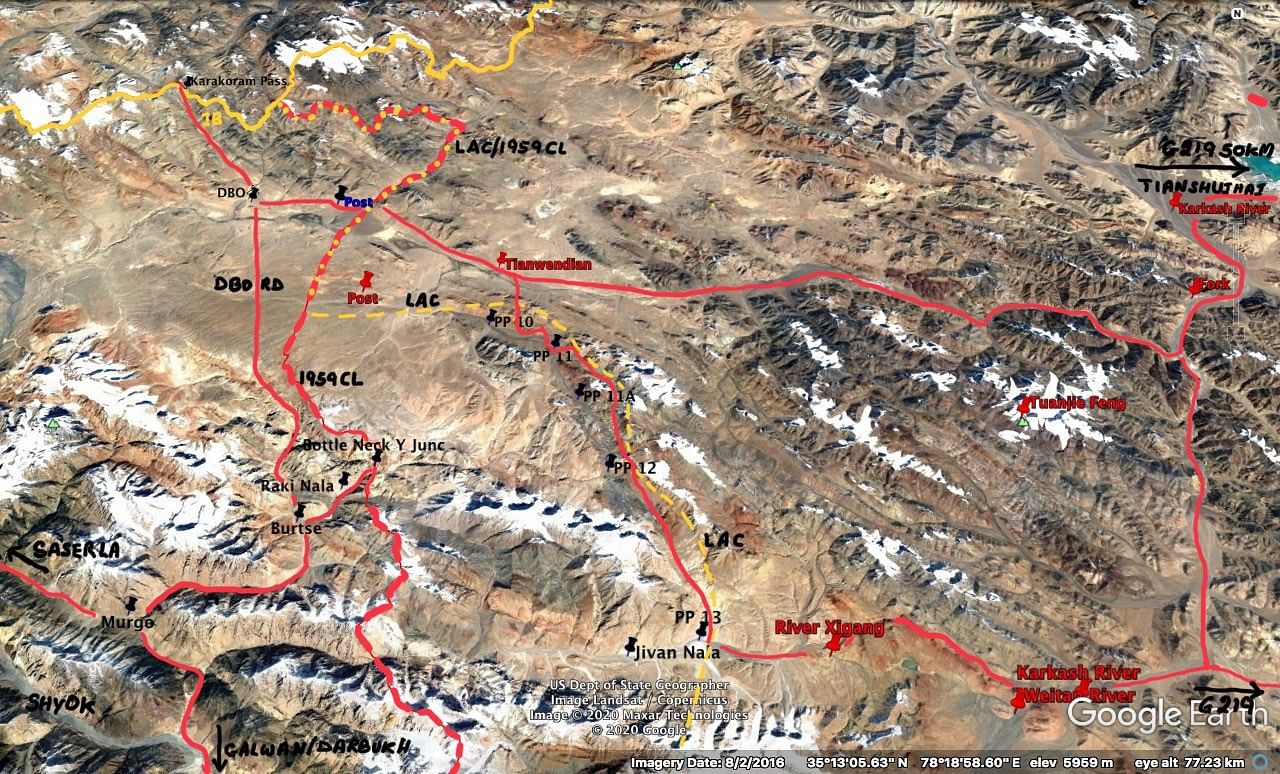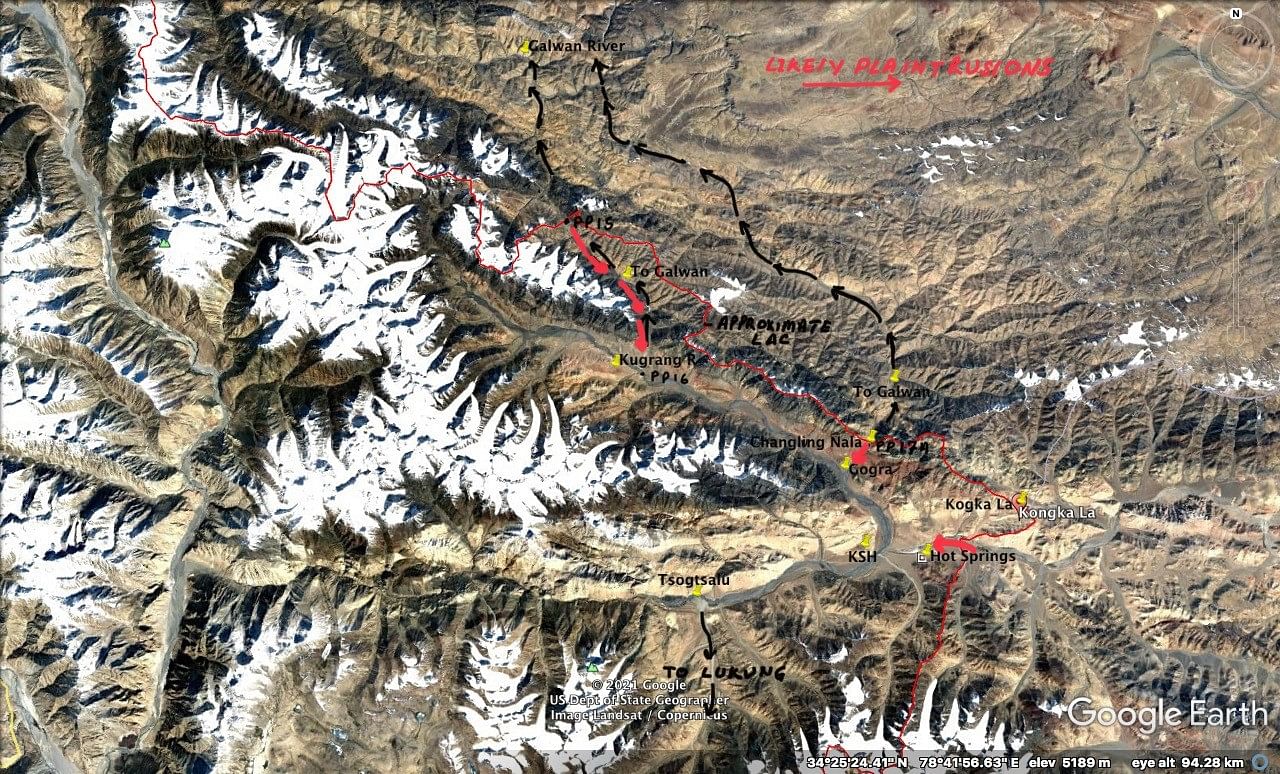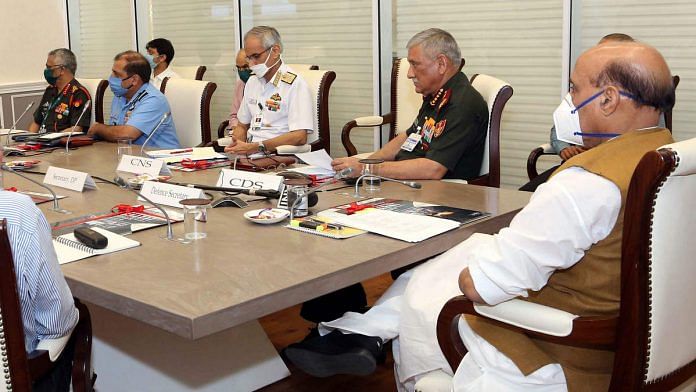There has been a phased but continuous source-based coverage and commentary about the lack of progress on the disengagement process — with special reference to Gogra-Hot Springs and Depsang Plains — since the 11th Corps Commander-level talks held on 9 April. In the past, deliberate ‘government leaks’ on the situation in Eastern Ladakh were given as handouts to all media houses and the story was broken almost simultaneously.
This time, such reports have appeared in different media outlets intermittently with slight variations to ensure their credibility. The intent seems to be to justify and shape public opinion to accept an ‘unfavourable peace’ that is being imposed on us by the Chinese.
The themes of the ‘unofficial briefings’
The Indian Express reported that Depsang was a legacy issue dating back to April-May 2013 intrusion, after which our patrols have been prevented from going beyond Bottle Neck/Y Junction up to Patrolling Points 10, 11, 12 and 13. The source emphasised that nothing new has happened in Depsang Plains during this entire crisis since April 2020, and that it was added to the list of friction areas so that it gets resolved. Thus, as of April 2020, the status quo has not changed in Depsang Plains. Even during the height of the standoff last year, the Chinese, the source quoted in the Express report said, were “not organised” for combat in Depsang Plains and Gogra-Hot Springs. The theme being propagated for public consumption is that there is nothing to resolve in Depsang Plains and that status quo never really changed.
The second theme being plied by the so-called “reliable sources” is that the Chinese are refusing to withdraw from Gogra-Hot Springs area, but they have a very limited presence — of approximately a platoon to a company on our side of the LAC — in areas of Patrolling Points 15 and 17A and that it is not really a flash point. This theme of information dissemination via the media plays down the serious implications of the Chinese intrusion in Gogra-Hot Springs and the threatening presence of a large number of Peoples’ Liberation Army (PLA) troops in this area.
The third theme of the “unofficial briefings” is that North and South Pangong Tso were the only areas where troops and tanks were in very close proximity to each other that could have escalated to war. The intent here seems to be to justify the now apparent “stand-alone agreement” for simultaneous withdrawal and the loss of “leverage” of our relatively advantageous deployment on the Kailash Range.
The fourth theme that has been brandied about is that China now wants deescalation of additional troops deployed before further disengagement takes place. The aim is to convey to the public that our massive deployment checkmated China and now there is no harm in agreeing for the same to diffuse the situation. More so, when there is nothing to resolve in Depsang Plains and differences in Gogra-Hot Springs with respect to disengagement are of a minor nature that will soon get resolved.
Also read: China deploys long-range rocket launchers in western theatre command as ‘deterrent to India’
Reality check
In the past one year, there has been no formal briefing about the situation in Eastern Ladakh. The quantum of Chinese forces, the extent of the intrusions and the details of the operations carried out have not been put in public domain. The media has not been given access to the operational area and has been spoon-fed through these “unofficial briefings”. Denial and obfuscation has been the predominant feature of the government’s political/unofficial statements. The media, afraid of annoying the government, failed to critically analyse the open domain information and provide a realistic assessment of the situation.
Let there be no doubt that China strategically surprised and preempted us with two/three mechanised divisions to secure areas up to the 1959 Claim Line in Depsang Plains and North of Pangong Tso, and in Gogra-Hot Springs even beyond the 1959 Claim Line. The Chinese were poised to capture the Daulat Beg Oldi Sector and entire area north and north-east of Pangong Tso, apart from threatening the Indus Valley up to the Ladakh Range. In early May 2020, our limited forces in Ladakh were no match for the PLA and all the above objectives were achievable. However, China had only a limited immediate aim of securing the 1959 Claim Line and preventing development of border infrastructure in critical areas, apart from the obvious assertion of its hegemony. Hence, it put the onus of further escalation on us.
After the initial surprise, we responded by confronting the Chinese with massive counter-deployment. Terrain configuration makes DBO and Gogra-Hot Springs sector defensively untenable in a limited war and, hence, rightly our focus was in North and South of Pangong Tso and the Indus Valley. Given the differential in military capability, we opted to stalemate the Chinese rather than resort to evicting them by an offensive action. This did not change the situation in the DBO Sector and Gogra-Hot Springs, which remained our critical vulnerabilities.
Our brilliant offensive manoeuvre to secure the Kailash Range on the night of 29-30 August created a military and political embarrassment for China. This led to diplomatic engagement and more meaningful military talks that culminated in disengagement from the North and South bank of Pangong Tso between 10 and 18 February. The 10th Corps Commander-level talks took place as per agreement exactly 48 hours later.
Let me reiterate that Depsang Plains and Gogra-Hot Springs continue to be our critical vulnerabilities and the Chinese have no intent to withdraw from there. The withdrawal from the North and South bank of Pangong Tso was a “stand-alone agreement” with no commitments from China to disengage from other sectors. Note the alleged contemptuous quote attributed to the Chinese in the recent talks — India “should be happy with what has been achieved”.
In a nutshell, the endeavour of the unofficial spokesperson(s) of the government is to obfuscate the reality and shape public opinion, possibly for an ‘unfavourable disengagement’ in Depsang Plains and Gogra-Hot Springs.
Two questions deserve to be answered. Why did India agree to a stand-alone agreement and vacate the Kailash Range? What are the terms of unfavourable peace likely to be imposed on us?
Also read: Backed by disruptive tech, China tried push & shove tactics but India stood firm: CDS Rawat
Standalone agreement
India’s securing of the Kailash Range was a great embarrassment for China. Domestically and internationally it lost face. The LAC passes over the crest of the Kailash Range, and thereafter there is a gradual plateau to the east, one to two km wide. India did not cross the LAC to secure this plateau and the eastern slopes. The PLA deployed its soldiers in matching strength opposite us on the plateau and also posed a threat to us from the Black Top, which also we had not secured. Moldo is not a garrison but a small post of PLA Border Guards. The main PLA base is well away. Thus, militarily, we were not posing a serious threat. In fact, our more serious threat was in the Indus Valley where we had concentrated our reserves.
It was the embarrassment and loss of face that led China to give up its absolutist position and come to the negotiating table. India insisted on an all-encompassing package to include North and South of Pangong Tso, Depsang, Gogra-Hot Springs and Demchok. It is my assessment that the Chinese issued a direct/indirect threat to go on the offensive in DBO and Gogra-Hot Springs sector. Given our critical vulnerability in these areas, we agreed to a “stand-alone agreement”.

Also read: Quad navies can come together if needed in almost ‘plug and play’ manner, Navy chief says
‘Unfavourable peace’
The DBO sector is defensively untenable in war. China is unlikely to make any compromise in Depsang Plains and we seem to have accepted it as a fait accompli. Hence, the narrative that it is a legacy issue where status quo April 2020 has not changed and that it was a dormant sector during the entire crisis.
We also seem to have accepted the intrusion south of Demchok in Charding-Ninglung Nala. Indeed, this is a legacy of the past. This intrusion does not create any vulnerability, and the 1959 Claim Line still remains 30 km to west and is under our firm control.
In Hot Springs-Gogra, the 1959 Claim Line and the LAC coincide. India has been aggressively developing roads along the Kugrang river and Chunglung Nala from where approaches lead north to upper reaches of the Galwan river. To ward off this threat, the Chinese have intruded from Changlung Nala and via upper reaches of the Kugrang river to deny us access to nearly 30-35 km-long and 4 km-wide Kugrang river valley beyond Gogra. We have no scope for any counter-action to gain leverage due to the 100-km-long tenuous road linking this area to Lukung. In the event of any escalation, the entire Chang Chenmo valley becomes defensively untenable as the road leading to it can be cutoff at Tsogtsalu / Marsimik La/ Phobrang. At best, what we can hope for is a buffer zone in the entire Kugrang river valley, which will entirely be in territory on our side of the LAC and which was under our control before May 2020.

We have stalemated the Chinese and denied them absolute victory. But Depsang Plains and Gogra-Hot Springs continue to remain our vulnerabilities and we have no counter-military leverage. It may be prudent to diffuse the crisis by negotiating buffer zones in these critical areas even if these entirely are on our side of the LAC. Rather than rely upon a false narrative, it is better to explain the situation to the public. It may appear to be “unfavourable peace” but given our vulnerabilities, it is the best we can hope for.
Lt Gen H S Panag PVSM, AVSM (R) served in the Indian Army for 40 years. He was GOC in C Northern Command and Central Command. Post retirement, he was Member of Armed Forces Tribunal. Views are personal.
Edited by Anurag Chaubey




Sir, the accompanying maps should hv been better annotated. All places mentioned in the article should hv been shown in the maps.
Well written. Govt does not want to suffer embarrassment. The disengagement should hv commenced from Depsang. It could be that Chinese threat in Depsang made us capitulate and hand over Kailash Range. It is quite obvious that having failed to manage Covid situation , 56″ does not want to be further dented by accepting that we failed to make Chinese withdraw. Hence making public believe that we achieved what we wanted to. Media doesn’t raise questions. Opposition is badly decimated. He can get away with this. It will be another legacy like those of past. But it is too bad.
Very well written like always.
Let us accept that china conquered indian territory.
Let us also be prepared for further chinese conquest of arinachsl oradesh
Let the indian govt now shrink map of india to reflect reality
We can’t trust press any more , as they can play into anyone’s hands . Truth Is that India stood firm , paying price for that in higher taxation. Political strength is given . Looks like China is trying to gain some advantage through friendly journolists
Time looks not good now, what China stole us not good for them they are cunning let the time come to show the same taste to them. Government should give genuine briefing to the public to decide how current generation and coming generations should treat Chines.
Time looks not good now, what China stole us not good for them they are cunning let the time come to show the same taste to them. Government should give genuine briefing to the public to decide how current generation and coming generations should treat Chines.
That India did not use the Kailash Ridge “Ace” to finesse the Gogra and Hot Springs King and Queen tell us the Indian Govt is playing a double game to appease both China and the Indian voters.
A barebone expression of truth! I like the articles by LT GEN H S PANAG (RETD) as it tells the truth how bitter that might be!
Yes, China has trespassed into Indian territory in Depsang plains, Gogra-Hot Springs area and is not budging, nor is it allowing Indian patrol. But how come China came there in the first place. China came there when India was not alert and has very less border patrol in those areas. The primary reason is that India’s infrastructure was not at all developed when the Chinese came there.
There is another bigger truth. China came there because of Mao’s one-China policy under which it occupied Tibet and it assumed all of Aksai Chin as part of Tibet. It all happened in 1950-52 and India was not aware. Only after China built the road and related infrastructure, India thought of telling China that it is India’s territory. But another bitter truth is that India had neither placed any border patrol, nor occupied it; It was barren land where not even grass is grown.
So what can be done now! India has to improve its infrastructure to such a level that it can attract tourists every year. It is untenable for the Chinese public to visit localities near the LAC as it’s too far. The only place they visit is Lhasa or the Everest. But for Indians it’s not only tenable, it is beneficial.
Oh General!…… your main focus is to needle the government and very unpleasant to note that some of the commanders on the LAC were your colleagues or senior only a few years back. You should be mindful of that.
Now Indian forces are fully built up in all areas to the same level as Chinese are hence any move by Chinese will be met with their death and destruction. You probably know it better that your colleagues surprised and embarrassed the Chinese on Aug 29/30 last year. They can still do it again, if Chinese are very aggressive. You, who has been a commander in the area know it better, hence hold off on your views and criticism. It is unbecoming of a retired commander to be critical of colleagues you left behind.
we are weak against Chinese economy. Indian needs to stop importing from China. This is urgent
Stopping imports from China idea was toyed last year but was not carried thru. The merchants in India went to China and bought $80 billion of stuff in-spite of Chinese behaviour at LAC. I think that to force the merchants buy locally, any imports from China should be 50% to 100% taxed as it arrives in India. That will force the importers to look internally first.
China has lit a fire which will now never extinguish.
Enmity of India is something China is going to face in very serious ways.
Ofcourse today they can afford to ignore India’s concerns. But we can develop our capabilities and partnerships with resolve and reply effectively at a time and place of our choice.
Let us resolve never to forget and never to forgive
Stop all trade With China.
Selling of Chinese goods shud be made a Criminal offense punishable with jail term.
This will create more jobs for Indians.
China has robbed the employment opportunities in other countries and later threatening most of the countries to show they are a super power.
If Chinese Is Not Understanding The GOI Language It Is Best Our Armed Forces Speak In Their Language.Let There Be No Further Pullbacks And Reoccupy The Heights.
With due respect, Sir your views are unidimensional:
– Chinese aim was to subdue India by capturing territory, give a message to our neighbours that India is unlikely to defend them in the face of Chinese aggression since it can’t defend its own borders, ensure that India kowtows to Chinese geo strategic positions wrt to USA and the border settlement will be India’s reward.
– China got an unexpectedly strong Indian response, got it’s tech banned from India, fundamentally changed India’s position to being somewhat neutral to being the the American corner and also drove up India’s military modernisation program in top gear.
– arguably the Chinese lost on most counts. This was due to both the military response and asymmetric tactics adopted by the govt
– yes, we may not have achieved full disengagement/desecalation, but that would be looking at things only from a military point of view and would be like missing the woods for the trees on the larger strategic picture
– India should infact prolong disengagement as much as possible and build all our military infrastructure required in the area as any future agreement may require us to stop building infra and thus putting us at a disadvantage.
Beautifully explained sir.
DBO looks like on borrowed time. Before next elections, this too would be likely to be addressed by China. That would be their way to put across their point.
Is this the time to share your horrible thinking at this time? Cant you wait for pandemic to subsidise to earn some extra bucks.
Really don’t understand what Mr. Panag was doing when he was the head of the Northern Command. Only if skills in writing could translate to action on the the ground during his career, or has he had a brainwave after retirement and has suddenly become an expert on tactical affairs ??? Or is it his career as an AAP member that rejuvenated his mind ?? ??